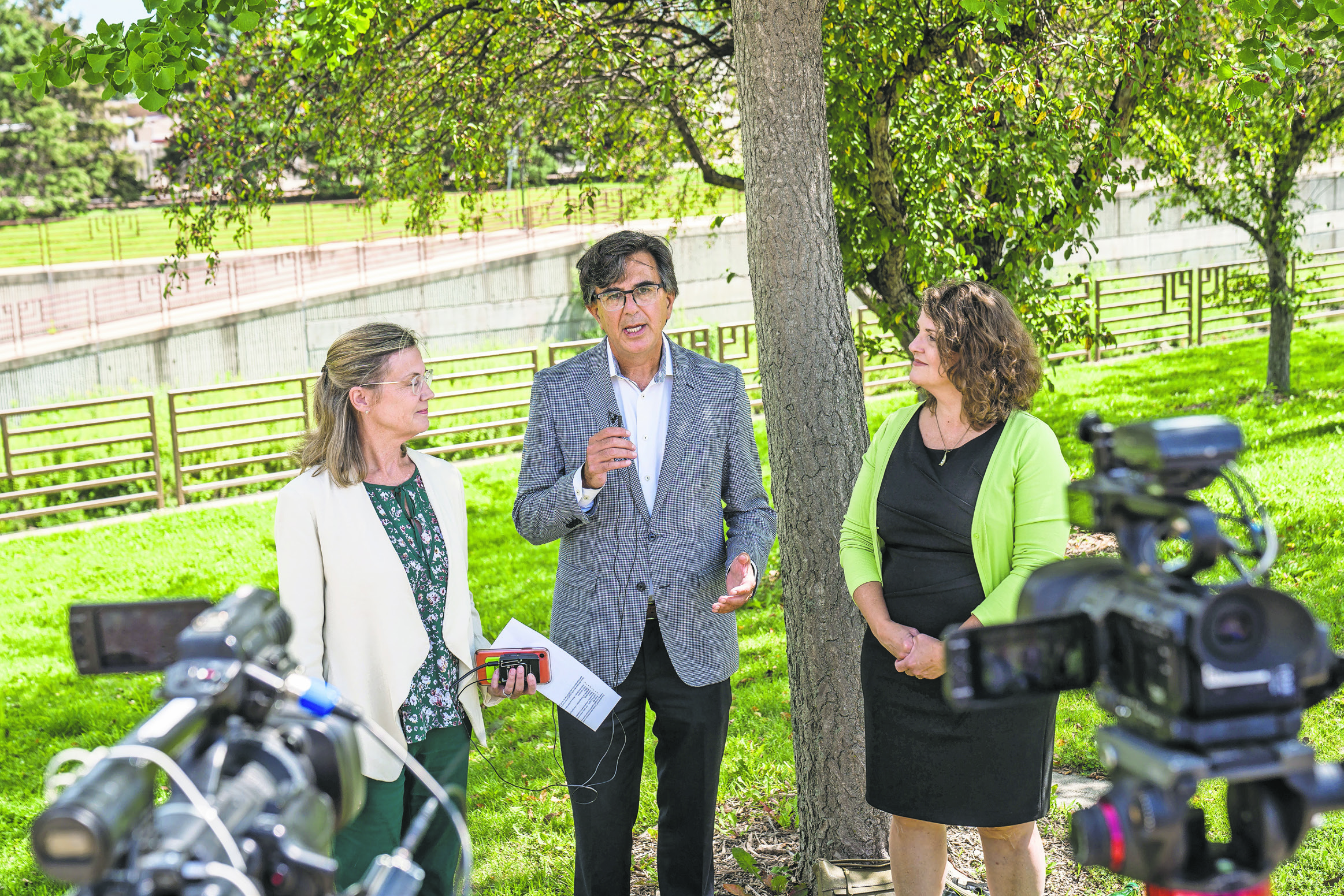
Mayor Kim Norton, left, Destination Medical Center Economic Development Agency Executive Director Patrick Seeb and Deputy City Administrator Cindy Steinhauser speak about the Sixth Street bridge project Thursday at a press conference in Rochester.

One option for the proposed Sixth Street Bridge over the Zumbro River calls for a 60-foot bridge deck that would provide access to vehicle and pedestrian traffic.
ROCHESTER
Construction of a Sixth Street bridge over the Zumbro River could start in 2024 with the announcement of $19.9 million in federal support.
The Department of Transportation announced Thursday that the Rochester project will benefit from a portion of $99.4 million in federal grants aimed to modernize transportation infrastructure in Minnesota.
“We are proud to support so many outstanding infrastructure projects in communities large and small, modernizing America’s transportation systems to make them safer, more affordable, more accessible, and more sustainable,” U.S.
Transportation Secretary Pete Buttigieg said in a statement announcing the funding for six projects in the state. “Using funds from President Biden’s Bipartisan Infrastructure Law, this year we are supporting more projects than ever before.”
The planned Sixth Street bridge remains in the design phase, but the Rochester City Council approved the federal grant application in March, with the possibility that it could fund up to 80% of the cost of the project.
Deputy City Administrator Cindy Steinhauser said final design is likely to last throughout 2023, with the expectation that the bridge will provide a crossing for vehicles, as well as pedestrians and bikes.
Mayor Kim Norton said the goal is to connect neighborhoods and potential development east of the river with the downtown.
“It’s a super important connection between Southeast Rochester and the rest of downtown,” she said.
Patrick Seeb, Destination Medical Center Economic Development Agency’s executive director, that connection is one of the reasons DMC state funds are expected to cover at least 20% of the project’s cost, but he said it goes beyond connecting two parts of the city.
“It’s more than about a bridge,” Seeb said, pointing out the structure will improve access to the riverfront and draw new interest to the area.
Cost estimates on a pair of early concepts presented in February ranged from $18 million to $20.2 million, but additional costs could emerge with the final design as inflation and supply issues linger.
While a Sixth Street Bridge has been proposed in the past, the recent effort emerged with the creation of a plan for possible development of 60 acres east of the river and south of Fourth Street.
The area includes the former AMPI and Kmart sites.
The city signed a $284,990 contract with architectural firm Perkins & Will last year for the initial bridge concepts presented this year, which included 60-foot- and 120-foot-wide options with a variety of amenities.
At least one Rochester City Council member has concerns that the federal funding has the project moving forward before it’s ready.
“I don’t want the money to be the deciding factor,” council member Molly Dennis said.
She cited concerns about potential traffic increases on Sixth Street Southeast, which passes near Riverside Elementary School.
During the review of the February concepts, other council members also cited concerns about traffic impacts through neighborhoods along Sixth Street on both sides of the bridge.
Steinhauser said the final design will seek to address Rochester City Council and community concerns and responses to the initial concepts.
She said the council will continue to be updated regarding options related to design and trafficcontrolling measures.
The federal funding award provides some insight on amenities that will need to be part of the and work that will extend along blocks of Sixth Street.
In addition to spanning the river at Sixth Street, the federal award anticipates the project will create new approaches on both sides of the bridge, connect Sixth Street to the Zumbro South Trail for improved river access, develop a new trail on the west bank of the river and improve safety at key intersections connected to the bridge.
“The project is expected to encourage redevelopment of brownfield sites in lowincome neighborhoods that have been historically bypassed due to lack of transportation access,” the funding announcement also states.
In addition to the Rochester funding, Thursday’s federal announcement includes:
• $9. 5 million for Big Woods Transit Facility construction by the Bois Forte Band of Chippewa.
• $18 million for the Minnesota Department of Transportation to reconstruct a portion of State Highway 197 in northern Minnesota.
• $12 million for Hennepin County to make planned Lake Street multimodal improvements to enhance bus rapid transit
• $15 million to Plymouth for its Station 73 Transit and Regional Improvement Program
• Nearly $25 million to Duluth to reconstruct approximately two miles of its West Superior Street active transportation corridor.
The federally supported projects were evaluated on several criteria, including safety, environmental sustainability, quality of life, economic competitiveness and opportunity, partnership and collaboration, innovation, state of good repair, and mobility and community connectivity.
Evaluations considered how projects will improve accessibility for all travelers, bolster supply chain efficiency and support racial equity and economic growth, especially in historically disadvantaged communities and areas of persistent poverty.
Contact local government reporter Randy Petersen at rpetersen@postbulletin.com.

